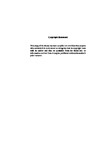Framework for Automated Functional Tests within Value-Added Service Environments
| dc.contributor.supervisor | Fuhrmann, Woldemar | |
| dc.contributor.author | Wacht, Patrick | |
| dc.contributor.other | School of Engineering, Computing and Mathematics | en_US |
| dc.date.accessioned | 2016-08-18T14:56:23Z | |
| dc.date.available | 2016-08-18T14:56:23Z | |
| dc.date.issued | 2016 | |
| dc.date.issued | 2016 | |
| dc.identifier | 10272858 | en_US |
| dc.identifier.uri | http://hdl.handle.net/10026.1/5335 | |
| dc.description | Full version unavailable due to 3rd party copyright restrictions. | |
| dc.description.abstract |
Recent years have witnessed that standard telecommunication services evolved more and more to next generation value-added services. This fact is accompanied by a change of service characteristics as new services are designed to fulfil the customer’s demands instead of just focussing on technologies and protocols. These demands can be very specific and, therefore, diverse potential service functionalities have to be considered by the service providers. To make matters worse for service providers, a fast transition from concept to market product and low price of a new service is required due to the increasing competition in the telecommunication industry. Therefore, effective test solutions need to be developed that can be integrated in current value-added service development life-cycles. Besides, these solutions should support the involvement of all participating stakeholders such as the service provider, the test developers as well as the service developers, and, in order to consider an agile approach, also the service customer. This thesis proposes a novel framework for functional testing that is based on a new sort of description language for value-added services (Service Test Description). Based on instances of the Service Test Description, sets of reusable test components described by means of an applied Statecharts notation are automatically selected and composed to so-called behaviour models. From the behaviour models, abstract test cases can be automatically generated which are then transformed to TTCN-3 test cases and then assembled to an Executable Test Suite. Within a TTCN-3 test system, the Executable Test Suite can be executed against the corresponding value-added service referred to as System Under Test. One benefit of the proposed framework is its application within standard development life-cycles. Therefore, the thesis presents a methodology that considers both service development and test development as parallel tasks and foresees procedures to synchronise the tasks and to allow an agile approach with customer involvement. The novel framework is validated through a proof-of-concept working prototype. Example value-added services have been chosen to illustrate the whole process from compiling instances of the Service Test Description until the execution of automated tests. Overall, this thesis presents a novel solution for service providers to improve the quality of their provided value-added services through automated functional testing procedures. It enables the early involvement of the customers into the service development life-cycle and also helps test developers and service developers to collaborate. | en_US |
| dc.language.iso | en | en_US |
| dc.publisher | Plymouth University | en_US |
| dc.subject | value-added service | en_US |
| dc.subject | automated functional testing | en_US |
| dc.subject | Next Generation Networks | en_US |
| dc.subject | TTCN-3 | en_US |
| dc.subject | verification and validation | en_US |
| dc.subject | agile development and testing | en_US |
| dc.title | Framework for Automated Functional Tests within Value-Added Service Environments | en_US |
| dc.type | Thesis | |
| plymouth.version | Edited version | en_US |
| dc.identifier.doi | http://dx.doi.org/10.24382/4717 |
Files in this item
This item appears in the following Collection(s)
-
01 Research Theses Main Collection
Research Theses Main


